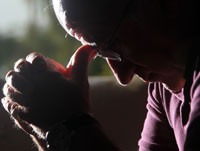
Staff cuts and overcrowded wards are blighting the care of detained mental health patients, the Care Quality Commission has warned.
A number of hospitals have cut staff, potentially undermining the safety and quality of care and leading to a lack of personalised support for patients, the regulator said in its 2010-11 report on the application of the Mental Health Act 1983 in England.
It cited the example of an 18-bed forensic ward that had cut staffing levels from five to three people on night duty and five to four during the day, leading to problems facilitating patients’ leave and increases in staff sickness.
In other services, reorganisations had led to long delays in dealing with staff vacancies, while reliance on bank and agency staff left some patients feeling insecure about their care.
It also said administrative posts were particularly vulnerable to being cut, despite administrators performing key functions under the Mental Health Act to ensure procedures are correctly followed.
The regulator also found evidence of nursing staff working 13-hour shifts, raising concerns about the impact on the physical and mental health of staff and on the quality of care.
Patient care was also being compromised by overcrowding in some wards. Though the Royal College of Psychiatrists recommends an 85% occupancy rate for beds, some wards were running at full or even over-capacity, leading to patients being accommodated in makeshift rooms and temporary beds, and delays to admissions.
In some cases, over-occupancy meant applications to admit people to hospital under the Act were lapsing because the 14-day time limit had expired, putting patients, potentially, at significant risk.
Mental health charities Mind and Sane raised concerns about the findings.
“The minimum patients should expect when being detained in hospital is personal safety and a bed for the night, yet the CQC found examples of overcrowding to the point where patients were accommodated in makeshift rooms and even sent away at night due to shortage of bed space,” said Mind chief executive Paul Farmer.
“Our major concern is the delay in admission for people assessed as being at risk because of a lack of beds,” said Sane chief executive Marjorie Wallace. “This can lead to untold distress for patients and families and in some cases tragic consequences.”
The CQC also raised concerns about the treatment of people on community treatment orders, under which patients in the community face conditions to ensure that they comply with treatment.
It found that patients on CTOs often did not have their rights explained to them by professionals, such as their right to an advocate or to appeal their orders at a tribunal. Patients on CTOs lacked access to independent mental health advocates (IMHAs), both because they were not aware of their rights to advocacy and because IMHA services lacked resources to support them.
The CQC also found that some professionals misunderstood the legal powers surrounding CTOs, leading to cases of unlawful treatment. For example, some professionals did not grasp that people on CTOs have the right to refuse medication without this being sufficient cause for them to be recalled to hospital.
The report also said that the number of patients on a CTO rose by 30% from April 2010 to March 2011, accounting for the vast majority of the rise in the number of patients subject to the Mental Health Act overall during the year, from 19,947 to 20,938.
The report was based on the work of the CQC’s Mental Health Act commissioners and second opinion appointed doctors, based on their visits to wards and discussions with patients and staff.
Related articles
CQC: Mental health services risk breaching patient rights
CQC: Mental health patients feel let down by services

 Bournemouth, Christchurch and Poole
Bournemouth, Christchurch and Poole  Hampshire County Council
Hampshire County Council  Lincolnshire County Council
Lincolnshire County Council  Norfolk County Council
Norfolk County Council  Northamptonshire Children’s Trust
Northamptonshire Children’s Trust  South Gloucestershire Council
South Gloucestershire Council  Wiltshire Council
Wiltshire Council  Wokingham Borough Council
Wokingham Borough Council  Children and young people with SEND are ‘valued and prioritised’ in Wiltshire, find inspectors
Children and young people with SEND are ‘valued and prioritised’ in Wiltshire, find inspectors  How specialist refugee teams benefit young people and social workers
How specialist refugee teams benefit young people and social workers  Podcast: returning to social work after becoming a first-time parent
Podcast: returning to social work after becoming a first-time parent  Podcast: would you work for an inadequate-rated service?
Podcast: would you work for an inadequate-rated service?  Family help: one local authority’s experience of the model
Family help: one local authority’s experience of the model  Workforce Insights – showcasing a selection of the sector’s top recruiters
Workforce Insights – showcasing a selection of the sector’s top recruiters 

 Facebook
Facebook X
X LinkedIn
LinkedIn Instagram
Instagram
Comments are closed.